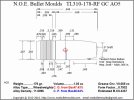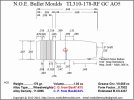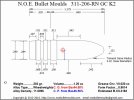Dimner
Named Man
Going back to the bullet that I discussed in this post: https://www.artfulbullet.com/index.php?threads/maths.8809/ , the NOE TL-310-178
It has been working well for me through my initial tests with my Winchester 94 and my M1 Garand. Accuracy at 50 yards is promising. Holes touching or nearly so with the Garand and open sights. Holes touching or even overlapping with the 94 and a scope. Holes nice and round (I can post pics if it's helpful)
However, something is happening with the bullet that is greatly affecting the actual Ballistic Cooeficient vs the Estimated BC based on form factor and sectional density.
Okay, calm your man boobies (as my daughter tells me). Yes I said BC. That always send the people in a flurry. I know in the real world BCs are different than estimations. I also know the BC isn't an end all be all number that we should hold in our dear hearts as something very important. I didn't buy the mold for it's BC. However, in this instance, the rather large deviation from the expected vs reality is telling me something is happening to the during ignition, barrel travel, and/or launch. I'm just not experienced enough to understand what that is.
Sure, so far accuracy looks good, but this is something I would like to solve.
Using my labradar and it's ability to measure velocity at multiple distances for each shot, I'm getting BC calculations of 0.190 to 0.210 with different powders with the 94 and Garand. The estimated BC for this bullet by NOE is 0.3337. That seems like a very large difference. I tend to trust NOE's estimate. BC estimation is done by SD divided by Form Factor. The only way to bungle an estimation would be to get their Form Factor value wrong. Sectional density is a straight forward calculation. Anyway, for this discussion, I'm thinking we should say NOE's estimate is within reason of what could be expected.
So why is the BC of my bullet reducing so drastically? I have a boatload of data I can sift through, just need to know what to look for. I put 75 rounds down range yesterday with various powders, all tracked by the labradar.
My first hunch is possible the alloy?
It has been working well for me through my initial tests with my Winchester 94 and my M1 Garand. Accuracy at 50 yards is promising. Holes touching or nearly so with the Garand and open sights. Holes touching or even overlapping with the 94 and a scope. Holes nice and round (I can post pics if it's helpful)
However, something is happening with the bullet that is greatly affecting the actual Ballistic Cooeficient vs the Estimated BC based on form factor and sectional density.
Okay, calm your man boobies (as my daughter tells me). Yes I said BC. That always send the people in a flurry. I know in the real world BCs are different than estimations. I also know the BC isn't an end all be all number that we should hold in our dear hearts as something very important. I didn't buy the mold for it's BC. However, in this instance, the rather large deviation from the expected vs reality is telling me something is happening to the during ignition, barrel travel, and/or launch. I'm just not experienced enough to understand what that is.
Sure, so far accuracy looks good, but this is something I would like to solve.
Using my labradar and it's ability to measure velocity at multiple distances for each shot, I'm getting BC calculations of 0.190 to 0.210 with different powders with the 94 and Garand. The estimated BC for this bullet by NOE is 0.3337. That seems like a very large difference. I tend to trust NOE's estimate. BC estimation is done by SD divided by Form Factor. The only way to bungle an estimation would be to get their Form Factor value wrong. Sectional density is a straight forward calculation. Anyway, for this discussion, I'm thinking we should say NOE's estimate is within reason of what could be expected.
So why is the BC of my bullet reducing so drastically? I have a boatload of data I can sift through, just need to know what to look for. I put 75 rounds down range yesterday with various powders, all tracked by the labradar.
My first hunch is possible the alloy?



